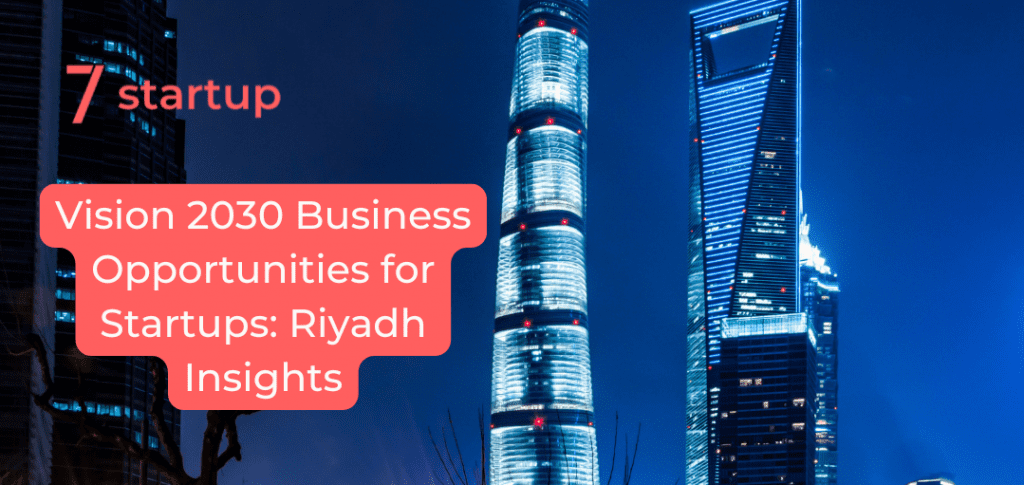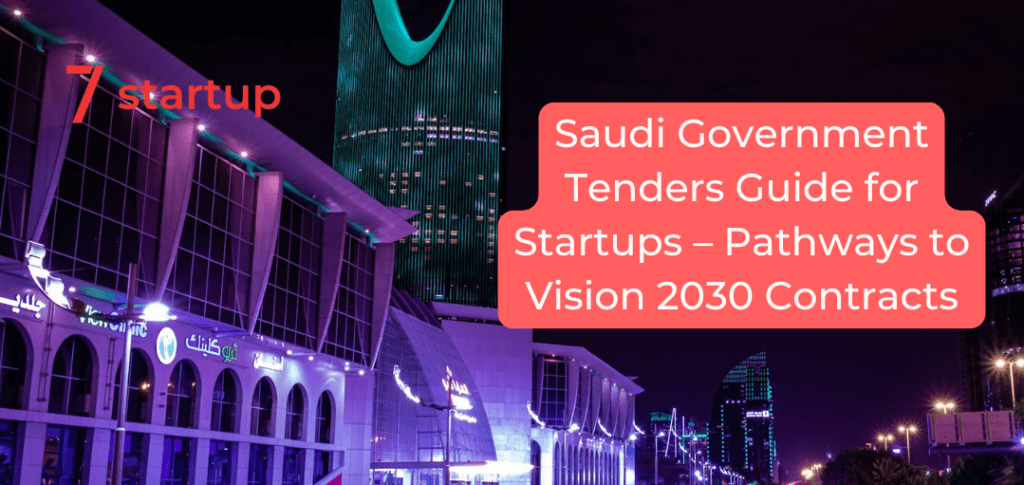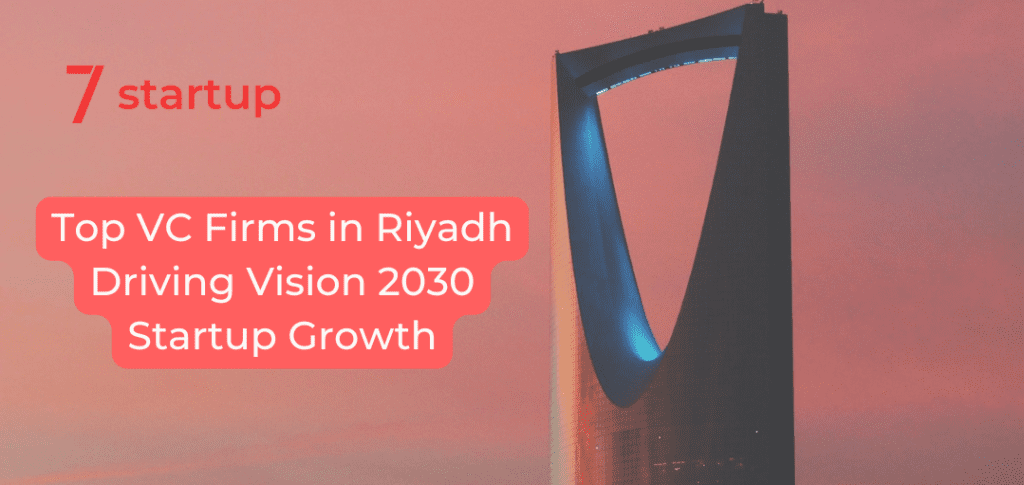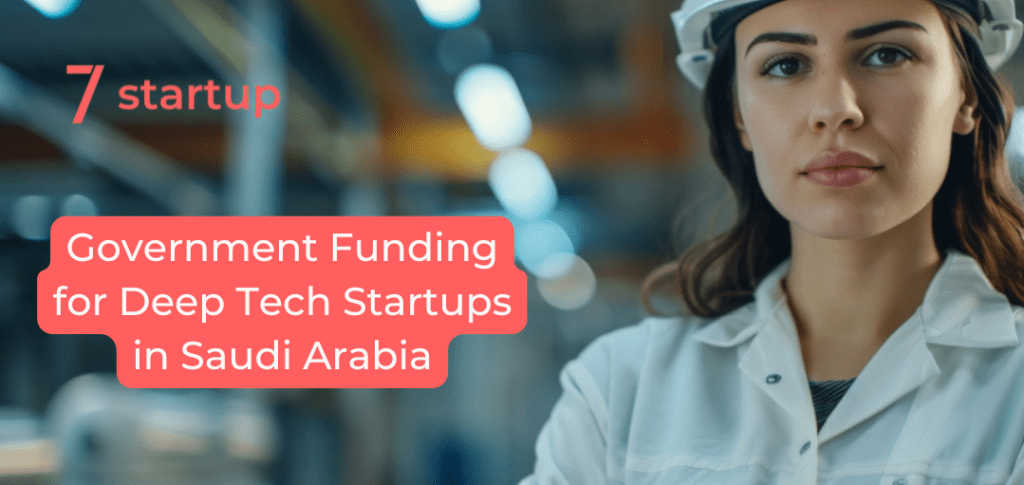Saudi Arabia’s Vision 2030 is unlocking unprecedented business opportunities for startups, scaleups, and investors across the globe. For founders in London, Riyadh, and other innovation hubs, the Kingdom’s trillion-dollar transformation program offers high-growth openings in renewable energy, AI, tourism, logistics, and critical minerals.
This guide unpacks the most lucrative Vision 2030 business opportunities, the government funding programs driving them, and the proven market-entry strategies that Western startups are using to scale in Saudi Arabia. Drawing on real case studies from London-based and Riyadh-based ventures, you’ll learn how to align with national priorities, navigate local compliance, and secure contracts in the Kingdom’s fastest-growing sectors.
Vision 2030 Business Opportunities for Global Startups


Vision 2030 rests on three pillars (Vibrant Society, Thriving Economy, Ambitious Nation) and routes capital through mega-programs (PIF portfolio, National Development Funds, line ministries). In 2024–2025, the state has both accelerators (record tourism numbers, grid‑scale renewables tenders, data‑centre push) and governance brakes(reprioritisation/impairments at some giga‑projects as oil revenues softened). Translation: there is still enormous demand, but the winning strategy is to sell into programmatic, budgeted streams – not just headline-making “moonshots.
What changed in 2025?
-
PIF recorded an ~$8bn writedown on domestic giga‑projects; procurement is becoming more selective and milestone‑driven. Founders should expect stricter vendor scrutiny and phased awards.
-
Tourism overshot the original 2030 target (100m) several years early and continued rising to 116m visits in 2024, pushing demand for mobility, hospitality tech, payments, and attraction operations.
-
The Kingdom doubled down on 50% renewables by 2030, awarding multi‑GW solar rounds and advancing the world’s largest green hydrogen project at NEOM.
-
Data‑centre capacity surged (290.5MW in 2023) and now targets ~1.3GW by 2030, with stc’s center3 alone aiming for 1GW opening doors for power systems, cooling, cybersecurity, DevOps, and AI cloud stacks.
London & Riyadh: Strategy for Vision 2030 Expansion
Step 1: Choose a program channel , not a “project brand”
Target ministries and operating companies with KPI‑backed budgets: SPPC/Ministry of Energy (renewables), center3/stc (DC/AI), RSG/STA/Ministry of Tourism (visitor ops), MOT/GA airports/ports (NTLS). Then map which Etimad entities issue tenders and which PIF portfolio companies co‑procure.
Step 2: Build your Localisation Stack
-
Legal & RHQ: Secure MISA licence; for public tenders, align to RHQ requirements (15+ headcount incl. executives; tax incentives via ZATCA rules).
-
Local content: Design for 10% price preference or more if you fall into listed categories. Include a measurable LC plan and audit path.
-
IKTVA (if selling into energy/PIF chains): develop a 3‑year localisation ramp.
-
Saudization: lock in a Nitaqat‑compliant org chart and training budget.
Step 3: Procurement readiness
-
Get on Etimad; align documentation (Arabic contracts/references, certified financials, bank guarantees). Understand price‑preference maths and mandatory lists under LCGPA.
-
If selling to PIF‑backed companies, expect phased milestones and localisation KPIs in contracts. Pay attention to delivery cadence, some giga‑projects are sequencing scope to manage capital.
Step 4: Go‑to‑market wedges (what actually opens doors)
-
Co‑bids with Tier‑1 EPCs and facility operators (Aramco/ACWA sub‑packages; airport/port ops; data‑centre SPVs).
-
Pilot‑to‑PPAs: for climate tech, tie pilots to power purchase or O&M outcomes; avoid “demo only.”
-
Saudi partner calculus: pick partners who bring distribution + compliance (LCGPA familiarity, Etimad rhythm), not just introductions.
Step 5: Capital & cashflow
-
Expect long contracting cycles; use London banking lines plus Saudi receivables finance where possible. Etimad’s claims module supports faster payment once milestones are verified.
Practical Market Entry Enablement: How VCaaS Fits the Vision 2030 Landscape
For many high-potential growth companies and SMEs, the opportunity in Saudi Arabia is clear but the execution gap is where deals are won or lost. Even with strong technology or proven traction in home markets, navigating licensing, localisation, Saudization, procurement platforms like Etimad, and giga-project integration can be complex.


This is where Venture Capital as a Service (VCaaS) operated by 7startup from its bases in London and Riyadh becomes a strategic enabler rather than just a funding vehicle.
Instead of leading with capital alone, VCaaS combines:
-
On-the-ground operational support to set up compliant, localised delivery
-
Government and enterprise relationship mapping to open doors to decision-makers aligned with Vision 2030 KPIs
-
Proof-of-Concept structuring to secure early credibility and milestone-based expansion
-
Flexible capital deployment once product–market fit and revenue visibility are proven in-Kingdom
For founders and SMEs, this means the market entry journey is not just about “getting in” it’s about staying in and scaling in step with Saudi Arabia’s national programs. Under Vision 2030’s trillion-dollar transformation plan, this operational-capital hybrid is proving to be a scalable path from initial contact to multi-year contracts.
High-Growth Sectors Under Saudi Vision 2030
1) Green hydrogen & renewables: infrastructure + offtake adjacency
The flagship NEOM Green Hydrogen Company (Air Products / ACWA Power / NEOM) reached $8.4bn financial close and is building a plant to produce ~600 t/day of green hydrogen (as ammonia). Construction progress disclosed in 2025 suggests first volumes by 2027. That reliability with financing closed, EPC set, offtake in place makes it a reference-grade anchor for technology and services SMEs (EPCM support, instrumentation, electrolyser balance-of-plant, ammonia handling, O&M, safety, training).
On the power side, Saudi continues to run large solar rounds under 25‑year PPAs (e.g., awards to TotalEnergies/EDF in late 2024; Aramco‑backed consortia across 2023‑2024), while policy anchors the 50% renewables ambition by 2030. If you’re a UK/EU climate‑tech or grid‑tech scale‑up, the go‑to motions now are: build local JV manufacturing (switchgear, trackers, cabling), grid integration software (curtailment, forecasting), and O&M digital twins – then route into SPPC/Ministry of Energy programs rather than one‑off pilots.
Startup founder moves that work:
-
Be the “component of reliability.” Pick a sub‑system where you can guarantee uptime (e.g., power electronics, safety valves, hydrogen compression skids).
-
Bankable warranties. Saudi asset owners prioritise lifecycle performance risk. Offer structured warranties, with local‑content uplift.
-
LC + IKTVA proof. If you sell to Aramco or PIF‑backed entities, have an IKTVA plan and local content auditors lined up. Aramco’s 2025 iktva forum explicitly tied awards to localisation, noting a 67% iktva score in 2024 procurement.
2) AI & data centres: from capacity race to stack integration
Saudi has moved from “data‑centre ambitions” to execution: 290.5MW capacity reported for 2023, a national ~1.3GWtarget by 2030, and center3 signalling 1GW by itself. Hyperscalers and national clouds need power optimisation, ESG reporting, DCIM software, sovereign‑AI stacks, and managed services especially those that meet localisation and security requirements.
What to sell (and to whom):
-
Power & thermal innovation: high‑efficiency UPS, liquid cooling integration, peak‑shaving controls sold to stc/center3, DataVolt, and hyperscaler JV SPVs.
-
AI MLOps with sovereign posture: toolchains tuned for Arabic LLMs, compliant logging, and in‑Kingdom data residency. Partnerships like Qualcomm × HUMAIN show depth of demand for AI infra and edge‑to‑cloud orchestration.
-
Resilience & cyber: SOC services with RHQ in Riyadh, plus local personnel to meet contract KPIs.
3) Logistics & mobility: sell into the National Transport & Logistics Strategy (NTLS)
The NTLS sets specific throughput ambitions “300+ million” air passengers and “4.5+ million” tonnes of air freight and continues to prioritise multi‑modal integration. Sell optimisation software into airports and ports, EV fleet telematics for tourism corridors, and bonded‑warehouse tech for e‑commerce. The decision maker is often not a single giga‑project but the operating company executing NTLS KPIs.
4) Tourism platforms and operating tech
Saudi exceeded 116m total visits in 2024 (30m inbound), lifting spend on payments, guest experience, ticketing, and workforce systems for hospitality and attractions. Bundle product with local content and Arabic UX; integrate SADAD/MADA; and be ready to support seasonality bursts (Ramadan, Hajj, Umrah).
5) Critical minerals & advanced materials
The UK and Saudi signed a critical minerals partnership in January 2025, with Saudi estimating $2.5tn in untapped resources, opening a channel for UK mining tech, ESG traceability, and processing. The catalytic venue: Future Minerals Forum (Riyadh), with direct line to MIM and Ma’aden.
Government Funding Driving Vision 2030 Business Opportunities
-
NEOM Green Hydrogen Company: $8.4bn project, EPC by Air Products, 30‑year offtake, targeting ~600 t/day; construction reported at ~80% in mid‑2025 with first product 2027 creating enduring scope for component suppliers and O&M tech.
-
Saudi renewables awards: 2024 tender round saw TotalEnergies/EDF win >1.7GW combined solar projects, under 25‑year PPAs—an anchor for grid integration, SCADA, and O&M software vendors.
-
Tamara (fintech): First Saudi fintech unicorn (Dec 2023, $340m Series C, $1bn valuation), backed by SNB Capital & Sanabil, an indicator of the Kingdom’s fintech scaling momentum and the viability of consumer rails innovation.
-
Data centre build‑out: stc’s center3 plans 1GW by 2030; MCIT reports 290.5MW capacity by end‑2023; national plan to reach ~1.3GW with direct demand for power systems, cooling, security, and AI stacks.
-
Tourism: Saudi recorded 116m visits in 2024 and reset its 2030 ambition to 150m; strong tailwinds for traveltech, venues, payments, and transport ops.
Proven Market Entry Framework for Vision 2030 Startups
A. Reprioritisation is real, budgeted programs beat “vision theatre”
Multiple reputable outlets reported PIF impairments and reprioritisation across giga‑projects. Don’t interpret that as “the door is closed”; it means sell into funded, measurable outcomes (power, water, mobility, digital infrastructure) and use giga‑projects selectively as channels, not as your only customer.
B. Local content rules change outcomes, price ≠ everything
LCGPA embeds 10% price preference for qualifying local products, with an additional mechanism (up to +20%) in designated pharma/medical categories. If your bid ignores local content, a rival can legally win above you. Structure JVs, local assembly, or certified “Made in KSA” components, and include the Local Content Certificate and measurement plan in your tender pack.
C. Procurement is digital and rules‑based
Most government procurement runs through Etimad, Saudi’s central platform, which also manages claims and payments. If you want public‑sector revenue, get Etimad‑ready (CR, MISA licence, ZATCA compliance, Saudization status). For government tenders from 1 Jan 2024, companies bidding typically need an approved Regional HQ (RHQ) in KSA.
D. Saudization (Nitaqat) is not optional
Sector‑ and size‑based Saudization quotas apply and are enforced. MHRSD’s updated Nitaqat framework (2021 reforms with 2024 guideline updates) requires workforce planning from the outset especially for service businesses. Build a talent localisation plan and factor it into your delivery model.
Startups Winning in Saudi Arabia’s Vision 2030
Tamara became Saudi’s first fintech unicorn in Dec 2023 after a $340m Series C co‑led by SNB Capital and PIF‑owned Sanabil, later receiving SAMA approvals in 2025 to expand licensed services. This is a textbook example of a Vision‑aligned vertical (payments/BNPL) scaling on top of tourism and retail growth, and integrating local rails and regulation to win. For western fintechs, the lesson is to co‑design with SAMA, integrate MADA/SADAD, and leverage RHQfor public‑sector adjacency (transport/tourism ticketing)
Challenges in Pursuing Vision 2030 Business Opportunities: How to Overcome Them
1) “We lost a tender even though we were cheaper.” Likely missed local content weighting. Build local assembly, get the Local Content Certificate, and include an audit‑ready LC plan to capture the 10% preference (or designated add‑ons).
2) “Our global payroll model breaks Saudization.” Design a Nitaqat‑compliant org structure from day one and fund training/knowledge transfer. This reduces compliance risk and improves Etimad scores downstream.
3) “We don’t know where to start with public sector.” Register on Etimad; shortlist target entities (airports, ports, SPPC, STA); present Arabic proposals; use RHQ to qualify for government tenders.
4) “Will gigaproject delays kill our pipeline?” Route to program KPIs (power, water, mobility, data) where budget cadence is clearer. Treat giga‑projects as channels to operating companies, not as the sole buyer.
Execution Checklist
-
Define your program beachhead (SPPC renewables, center3 AI/DC, NTLS nodes, STA venues).
-
Secure MISA licence and RHQ if bidding public; staff the 15‑role baseline early.
-
Local content & IKTVA plans in the bid pack; pick an accredited auditor.
-
Saudization plan (roles, training, scholarships); build your leadership bench in Riyadh.
-
Etimad registration and pipeline tracking; Arabic‑first tenders; performance bonds ready.
-
Cashflow: structure receivables finance; exploit Etimad claims workflows for faster payment.
-
Risk lens: pace giga‑project exposure; prioritise budgeted, KPI‑linked streams.
Conclusion: Turning Vision 2030 Goals into Startup Wins


For founders and investors ready to move, 7startup can help you sequence the play: diligence the program beachhead, stand up RHQ and localisation, source the right co‑bid partners, and build the procurement cadence. If you’re a government or PIF‑backed buyer, we can curate UK/EU deep‑tech vendors with LC/IKTVA‑ready delivery to de‑risk your outcomes.
FAQs
Q: What is Vision 2030 and why is it a business opportunity?
A: Vision 2030 is Saudi Arabia’s national transformation plan, investing over $1 trillion to diversify the economy. It creates high-growth openings in renewable energy, AI, tourism, and logistics, offering startups first-mover advantages in a rapidly reforming market.
Q: Which sectors have the biggest Vision 2030 business opportunities?
A: Renewable energy, AI and digital transformation, tourism, logistics, and mining are leading growth areas. Each is backed by government funding, giga-project integration, and foreign ownership reforms.
Q: Can London-based startups benefit from Vision 2030?
A: Yes. London startups can use Riyadh as a regional base, leverage UK–Saudi trade agreements, and access Vision 2030 programs to scale into Saudi Arabia and the wider GCC.
Q: What is the best way to enter the Saudi market under Vision 2030?
A: Align with national sector priorities, secure a local partner or RHQ licence in Riyadh, apply for relevant government funding, and launch with a proof of concept to build credibility.
Q: Is Saudi Arabia open to foreign startups under Vision 2030?
A: Yes. Reforms allow 100% foreign ownership in most sectors, streamlined licensing, and incentives like tax breaks and grants to attract international innovation.




